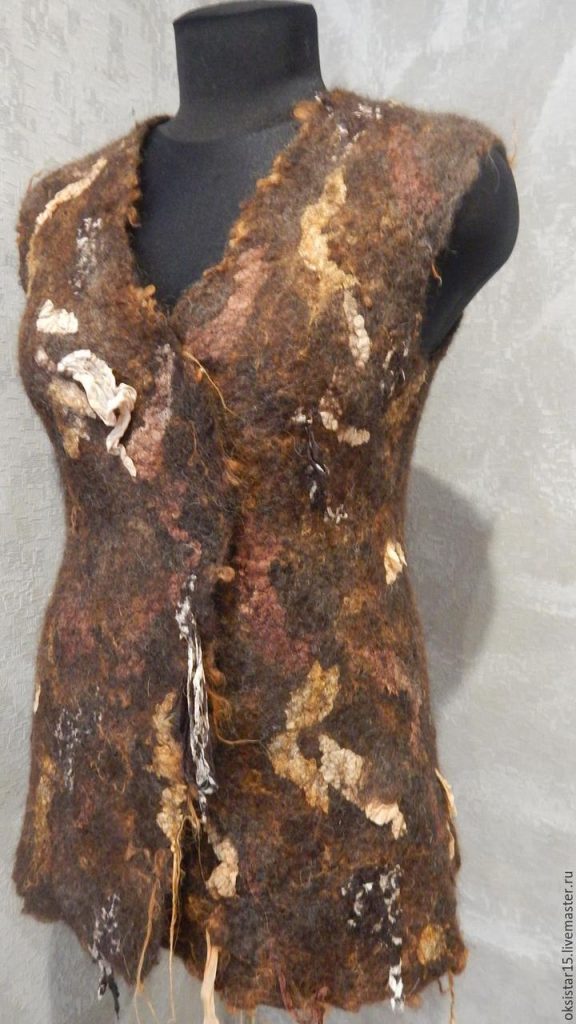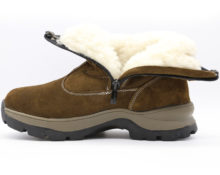
creativecommons.org
Felted items are associated with comfort and warmth. Sooner or later, many decide that felted vests can be a worthy alternative to a woolen sweater or jumper. In this article you will find recommendations for choosing felted vests and what everyday accessories you can wear this unusual wardrobe item with. At the end of the material there are photos and ideas for an original image.
History of felting
Felting is probably one of the oldest methods of processing fabric. It is difficult to say where exactly they first learned to felt from wool. There are also disputes about the period. Scientists focus on the period when people tamed sheep and began to domesticate livestock - approximately 9,000 years ago. Most likely, these were northern peoples who were forced to survive in a difficult climate.Although the first legend associated with the production of felt appeared among the Sumerians, according to which the warrior and hero Ur-Nammu learned to felt wool, he gave this knowledge to his people. It is known that Sumerian warriors wore thick felt ammunition instead of armor, the upper part of which looked a little like felted vests. European tradition claims that the process of felting wool was introduced to medieval society by St. Clement, the future fourth pope. There is even a biblical version of the creation of felt: the process of felting was discovered completely by accident, when the animals on Noah's Ark began to shed and trample their wool with their paws and hooves, creating a large felt carpet. Eurasian nomads made almost all their household utensils from felt: tents for yurts, upper parts of shoes, clothes, pillows, carpets, bags for supplies and even sleeping places. It is believed that felt appeared in Rus' with the arrival of the Mongol-Tatars; The famous Russian felt boots began to be felted much later. The first felted vests appeared only in the 17th century and were part of military uniforms.
Features and techniques of felting
The first felt was not bright (mostly gray, black and brown), so it was decorated with inserts made of genuine leather and colored fabric or embroidered with threads. White felt was also found, but felting items made from this rare material required more time, so items made from it were worn on holidays. Basically, craftsmen use two felting techniques: dry - performed with special needles (used to create toys and jewelry), and wet - used for felting clothes and other flat products.
How to choose the right felted vest
First of all, you need to focus on the composition of the felted vest. Today, more advanced raw materials are used for felting wool. The wool of Merino sheep is softer and thinner than that of other types of sheep, so craftsmen prefer to work with it. Craftswomen have turned wool felting into a real art and are constantly inventing new ways of decoration. So, it is quite unexpected that sometimes felt is combined with solid textures, such as ceramics, glass and even metal.

creativecommons.org
What is the best way to wear a felted vest?
Historically, felted vests (like vests in general) were men's clothing. These items were worn by the military during the Russian-Polish war in the 17th century and they were worn under clothing, not on it. In the 19th century, the felted vest became part of the women's wardrobe and became an option for summer outerwear. The felted vest acquired its modern appearance at the end of the 19th century: it began to be worn in winter and was worn under clothes. Probably because of the masculine past of the vest, today many fashionistas wear it mainly with trousers or jeans. Most often, modern vests take the strict form of sleeveless jackets and fit harmoniously into an office wardrobe. Many people wear felted vests as cardigans, wearing a shirt or (less often) a dress made of a plain fabric underneath. This piece of clothing can become an original decoration decorated in a national style, with decor in the form of original embroidery, adding inserts of velvet, leather or fur.


 0
0





